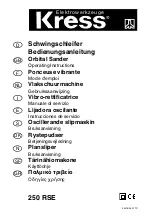
HELPLINE NO 08454 505299
4
ORIGINAL INSTRUCTIONS
Replace damaged cords immediately.
•
Unplug your tools before mounting or
replacing accessories.
ADDITIONAL SAFETY
RULES FOR YOUR
MULTI-SANDER
•
Never use your multi-sander for wet
sanding with accessories, also for
sawing, scraping, cutting, polishing, and
separating.
•
Always wear eye protection.
•
Always wear ear protection during
extended periods of operation.
•
Always wear a dust mask if the operation
is dusty.
•
Always inspect and remove all nails and
screws etc before sanding.
•
Always check walls and ceilings to avoid
hidden power cables and pipes. A metal
detector can be obtained from any good
DIY store for this purpose.
•
If possible, use clamping devices or other
suitable means to secure the workpiece
to a firm surface.
•
Use the original accessories and the tool
provided, no others.
•
Only use accessories in good condition.
Do not use torn or worn accessories.
•
Do not use a damaged plug and cable, if
damaged have them repaired. Always be
aware of the cord location.
•
Do not abuse the cord. Never use the
cord to carry the tools or pull the plug
from the outlet. Keep cord away from
heat, oil, sharp edges or moving parts.
This will ensure that the safety of the
power tool is maintained.
• If the replacement of the supply
cord is necessary, this has to be done
by the manufacturer or his agent
in order to avoid a safety hazard.
WARNING!
Some dust particles created by power
sanding, contain chemicals known to
cause cancer, birth defects or other
reproductive harm.
Some examples of these chemicals
are:
• Lead from lead-based paints.
• Crystalline silica from bricks and cement
and other masonry products.
• Arsenic and chromium from chemically
treated lumber.
Your risk from these exposures varies,
depending upon how often you do this type
of work. To reduce your exposure to these
chemicals:
• Work in a well-ventilated area.
• Work with approved safety equipment,
such as those dust masks that are specially
designed to filter microscopic particles.
• Caution, fire hazard! Avoid
overheating the object being
sanded as well as the sander.
• Always empty the dust box before
taking breaks.
In unfavorable
conditions, e.g., when sparks emit from
sanding metals, sanding debris in the dust
box, micro filter or paper sack (or in the
filter sack or filter of the vacuum cleaner)
can self-ignite. Particularly when mixed
with remainders of varnish, polyurethane
or other chemical materials and when the
sanding debris is hot after long periods of
working.
• Keep your workplace clean.
Blends
of materials are particularly dangerous.
Dust from light alloys can burn or explode.

































